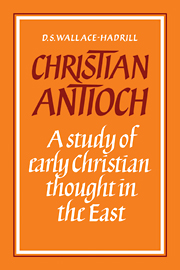Book contents
- Frontmatter
- Contents
- Foreword
- Abbreviations
- Introduction: survey of the history of Antioch
- 1 The religious background to Antiochene Christianity: pagan, Jewish, gnostic
- 2 The interpretation of the biblical record
- 3 Historiography in the Eastern Church
- 4 The doctrine of the nature of God
- 5 The use of Greek philosophy by the Eastern Church
- 6 The human experience of Christ and the salvation of man
- 7 Antiochene theology and the religious life
- Appendix 1 Eastern representation at Nicaea
- Appendix 2 The feminine element in Syrian Christianity
- Notes
- Bibliography
- Index
Appendix 2 - The feminine element in Syrian Christianity
Published online by Cambridge University Press: 03 May 2010
- Frontmatter
- Contents
- Foreword
- Abbreviations
- Introduction: survey of the history of Antioch
- 1 The religious background to Antiochene Christianity: pagan, Jewish, gnostic
- 2 The interpretation of the biblical record
- 3 Historiography in the Eastern Church
- 4 The doctrine of the nature of God
- 5 The use of Greek philosophy by the Eastern Church
- 6 The human experience of Christ and the salvation of man
- 7 Antiochene theology and the religious life
- Appendix 1 Eastern representation at Nicaea
- Appendix 2 The feminine element in Syrian Christianity
- Notes
- Bibliography
- Index
Summary
With the feminine element in the Syrian conception of deity we may associate the importance of the feminine element in Semitic cultus from earliest times: see S. H. Hooke, The Seige Perilous, London, 1956, p. 104, on primitive fertility prostitution rites in Israel; F. Cumont, Les Religions Orientates dans le Paganisme Romain, 4th ed., Paris, 1949, p. 106 on prostitution in the Elagabal temple at Emesa; E. S. Bouchier, Syria as a Roman Province, Oxford, 1916, p. 261 on the part played by ecstatic women in the worship of Atargatis at Heliopolis. In justifying the destruction of such sites, much use was made by Christians of the prostitution practised there, e.g. Eus., V.C.,iii.55; so R. Dussaud, Mana,i.2, Paris, 1949, p. 399. The feminine element in the cultus is maintained strongly in Simon Magus and his associate Helen, who was variously identified with Helen of Troy; the feminine Sophia of Prov., viii.22ff.; Korě, the daughter of Zeus; Athena; Isis, and other divine figures, exemplifying the complex cross-fertilization of myth underlying accounts of her (R. M. Grant, Gnosticism and Early Christianity, New York, 1959, p. 84). Grant suggests (p. 82) that descriptions of Helen as a prostitute may have been hostile inventions. The same may be true of the accusation of unchastity levelled at Paul of Samosata on account of his female choir, who may exemplify not simply the rich Syrian tradition of hymnody but also the Syrian feminine tradition, subjected to denigration by later critics of Paul.
- Type
- Chapter
- Information
- Christian AntiochA Study of Early Christian Thought in the East, pp. 167 - 168Publisher: Cambridge University PressPrint publication year: 1982

